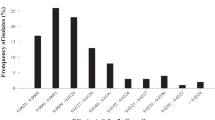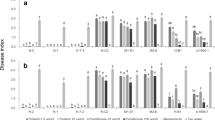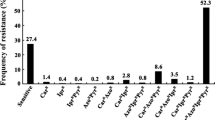Abstract
Gray mold caused by Botrytis cinerea is the major postharvest disease in table grapes grown in the Central Valley of California. Preharvest use of fungicide sprays may provide an alternative to the control of postharvest gray mold. However, fungicide resistance in B. cinerea can result in the failure of disease control. In this study, 212 isolates of B. cinerea were collected from table grape vineyards in three table grape-producing counties in the region and tested for resistance to selected fungicides on fungicide-amended media. In addition, 80 isolates were tested to establish baseline sensitivity to the newer fungicide fluopyram. Seven fungicide-resistant phenotypes were detected; 85.0%, 23.1%, 13.7%, and 94.8% of the isolates were resistant to boscalid, cyprodinil, fenhexamid, and pyraclostrobin, respectively. All isolates were sensitive to fludioxonil. Only 5.2% of the isolates were sensitive to all fungicides tested, whereas 8.9%, 56.1%, 23.6% and 6.1% were resistant to one, two, three, and four modes-of-action fungicides, respectively. Of the 80 isolates tested, all were sensitive to fluopyram with EC50 values ranging from 0.001 to 0.054 μg/mL. Most fungicides failed to control gray mold on detached table grapes inoculated with respective fungicide-resistant phenotypes. Our results suggest that alternation of sprays using different classes of fungicides will be needed to control postharvest gray mold, and that fludioxonil and fluopyram could be effective fungicides integrated into a preharvest fungicide spray program for control of gray mold in table grapes in the Central Valley of California.

Similar content being viewed by others
References
Amiri, A., & Peres, N. A. (2014). Diversity in the erg27 gene of Botrytis cinerea field isolates from strawberry defines different levels of resistance to the hydroxianilide fenhexamid. Plant Disease, 98, 1131–1137.
Amiri, A., Heath, S. M., & Peres, N. A. (2013). Phenotypic characterization of muti fungicide resistance in Botrytis cinerea isolates from strawberry fields in Florida. Plant Disease, 97, 393–401.
Amiri, A., Heath, S. M., & Peres, N. A. (2014). Resistance to fluopyram, fluxapyroxad, and penthiopyrad in Botrytis cinerea from strawberry. Plant Disease, 98, 532–539.
Amiri, A., Mulvaney, K. A., Pandit, L. K., & Angelis, D. R. (2017). First report of resistance to fluxapyroxad and fluopyram in Botrytis cinerea from commercial apple orchards in Washington state. Plant Disease, 101, 508.
Angelini, R. M. D. M., Rotolo, C., Masiello, M., Gerin, D., Pollastro, S., & Faretra, F. (2014). Occurrence of fungicide resistance in populations of Botryotinia fuckeliana (Botrytis cinerea) on table grape and strawberry in southern Italy. Pest Management Science, 70, 1785–1796.
Avenot, H. F., Sellam, A., Karaoglanidis, G., & Michailides, T. J. (2008). Characterization of mutations in the iron-Sulphur subunit of succinate dehydrogenase correlating with boscalid resistance in Alternaria alternata from California pistachio. Phytopathology, 98, 736–742.
Feliziani, E., Romanazzi, G., & Smilanick, J. L. (2014). Application of low concentrations of ozone during the cold storage of table grapes. Postharvest Biology and Technology, 93, 38–48.
Fernández-Ortuño, D., Chen, F., & Schnabel, G. (2013). Resistance to cyprodinil and lack of fludioxonil resistance in Botrytis cinerea isolates from strawberry in north and South Carolina. Plant Disease, 97, 81–85.
Fernández-Ortuño, D., Grabke, A., Bryson, P. K., Amiri, A., Peres, N. A., & Schnabel, G. (2014). Fungicide resistance profiles in Botrytis cinerea from strawberry fields of seven southern U. S. States. Plant Disease, 98, 825–833.
Fernández-Ortuño, D., Grabke, A., Li, X., & Schnabel, G. (2015). Independent emergence of resistance to seven chemical classes of fungicides in Botrytis cinerea. Phytopathology, 105, 424–432.
Fraaije, B. A., Bayon, C., Atkins, S., Cools, H. J., Lucas, J. A., & Fraaije, M. W. (2012). Risk assessment studies on succinate dehydrogenase inhibitors, the new weapons in the battle to control Septoria leaf blotch in wheat. Molecular Plant Pathology, 13, 263–275.
Gabler, F. M., Smilanick, J. L., Mansour, M., Ramming, D. W., & Mackey, B. E. (2003). Correlations of morphological, anatomical, and chemical features of grape berries with resistance to Botrytis cinerea. Phytopathology, 93, 1263–1273.
Grabke, A., Fernández-Ortuño, D., & Schunabel, G. (2013). Fenhexamid resistance in Botrytis cinerea from strawberry fields in the Carolinas is associated with four target gene mutations. Plant Disease, 97, 271–276.
Hilber, U. W., & Schüepp, H. (1996). A reliable method for testing the sensitivity of Botryotinia fuckeliana to anilinopyrimidines in vitro. Pesticide Science, 47, 241–247.
Ishii, H., Fountaine, J., Chung, W.-H., Kansako, M., Nishimura, K., Takahashi, K., & Oshima, M. (2009). Characterisation of QoI-resistant field isolates of Botrytis cinerea from citrus and strawberry. Pest Management Science, 65, 916–922.
Ishii, H., Miyamoto, T., Ushio, S., & Kakishima, M. (2011). Lack of cross-resistance to a novel succinate dehydrogenase inhibitor, fluopyram, in highly boscalid-resistant isolates of Corynespora cassiicola and Podosphaera xanthii. Pest Management Science, 67, 474–482.
Kim, Y. K., & Xiao, C. L. (2011). Stability and fitness of pyraclostrobin- and boscalid-resistant phenotypes in field isolates of Botrytis cinerea from apple. Phytopathology, 101, 1385–1391.
Konstantinou, S., Karaoglanidis, G. S., Bardas, G. A., Minas, I. S., Doukas, E., & Markoglou, A. N. (2011). Postharvest fruit rots of apple in Greece: Pathogen incidence and relationships between fruit quality parameters, cultivar susceptibility, and patulin production. Plant Disease, 95, 666–672.
Leroch, M., Plesken, C., Weber, R. W. S., Kauff, F., Scalliet, G., & Hahn, M. (2013). Gray mold populations in German strawberry fields are resistant to multiple fungicides and dominated by a novel clade closely related to Botrytis cinerea. Applied and Environmental Microbiology, 79, 159–167.
Leroux, P., Chapeland, F., Desbrosses, D., & Gredt, M. (1999). Patterns of cross-resistance to fungicides in Botryotinia fuckeliana (Botrytis cinerea) isolates from French vineyards. Crop Protection, 18, 687–697.
Li, X., Fernandez-Ortuño, D., Grabke, A., & Schnabel, G. (2014). Resistance to fludioxonil in Botrytis cinerea isolates from blackberry and strawberry. Plant Disease, 104, 724–732.
Lichter, A., Zutahy, Y., Kaplonov, T., Aharoni, N., & Lurie, S. (2005). The effect of ethanol dip and modified atmosphere on prevention of Botrytis rot of table grapes. HortTechnology, 15, 9–16.
Mondal, S. N., Bharia, A., Shilts, T., & Timmer, L. W. (2005). Baseline sensitivities of fungal pathogens of fruit and foliage of citrus to azoxystrobin, pyraclostrobin, and fenbuconazole. Plant Disease, 89, 1186–1194.
Myresiotis, C. K., Karaoglanidis, G. S., & Tzavella-Klonari, K. (2007). Resistance of Botrytis cinerea isolates from vegetable crops to anilinopyrimidine, phenylpyrrole, hydroxyanilide, benzimidazole, and dicarboximide fungicides. Plant Disease, 91, 407–413.
Nelson, K. E. (1985). Harvesting and handling California table grapes for market. Bulletin. 1913, University of California Division of Agriculture and Natural Resources.
Panebianco, A., Castello, I., Cirvilleri, G., Perrone, G., Epifani, F., Ferrara, M., Polizzi, G., Walters, D. R., & Vitale, A. (2015). Detection of Botrytis cinerea field isolates with multiple fungicide resistance from table grape in Sicily. Crop Protection, 77, 65–73.
Perveen, F., & Hussain, Z. (2012). Review: Use of statistical techniques in analysis of biological data. Basic Research Journal of Agricultural Science, 1, 1–10.
Romanazzi, G., Gabler, F. M., Margosan, D., Mackey, B. E., & Smilanick, J. L. (2009). Effect of chitosan dissolved in different acids on its ability to control postharvest gray mold of table grape. Phytopathology, 99, 1028–1036.
Romanazzi, G., Lichter, A., Gabler, M. F., & Smilanick, J. L. (2012). Recent advances on the use of natural and safe alternatives to conventional methods to control postharvest gray mold of table grapes. Postharvest Biology and Technology, 63, 141–147.
Rupp, S., Weber, R. W. S., Rieger, D., Detzel, P., & Hahn, M. (2017). Spread of Botrytis cinerea strains with multiple fungicide resistance in German horticulture. Frontiers in Microbiology, 7, 2075.
Russell, P. E. (2004). Sensitivity baselines in fungicide resistance research and management. FRAC, Monograph. No. 3, Brussels, Belgium: Crop Life International.
Saito, S., Cadle-Davidson, L., & Wilcox, F. W. (2014). Selection, fitness and control of Botrytis cinerea isolates from grapes variably sensitive to fenhexamid. Plant Disease, 98, 233–240.
Saito, S., Michailides, T. J., & Xiao, C. L. (2016a). Fungicide resistance profiling in Botrytis cinerea populations from blueberry in California and Washington and their impact on control of gray mold. Plant Disease, 100, 2087–2093.
Saito, S., Margosan, D., Michailides, T. J., & Xiao, C. L. (2016b). Botrytis californica, a new cryptic species in the B. cinerea species complex ausing gray mold in blueberries and table grapes. Mycologia, 108, 330–343.
Smilanick, J. L., Mansour, M. F., Gabler, F. M., Margosan, D. A., & Hashim-Buckey, J. (2010). Control of postharvest gray mold of table grapes in the San Joaquin Valley of California by fungicides applied during the growing season. Plant Disease, 94, 250–257.
Veloukas, T., & Karaoglandis, G. S. (2012). Biological activity of the succinate dehydrogenase inhibitor fluopyram against Botrytis cinerea and fungal baseline sensitivity. Pest Management Science, 68, 858–864.
Veloukas, T., Leroch, M., Hahn, M., & Karaoglandis, G. S. (2011). Detection and molecular characterization of boscalid-resistant Botrytis cinerea isolates from strawberry. Plant Disease, 95, 118–122.
Veloukas, T., Markoglou, N. A., & Karaoglanidis, G. S. (2013). Differential effect of SdhB gene mutations of the sensitivity to SDHI fungicides in Botrytis cinerea. Plant Disease, 97, 118–122.
Veloukas, T., Kalogeropoulou, P., Markoglou, A. N., & Karaoglanidis, G. S. (2014). Fitness and competitive ability of Botrytis cinerea field isolates with dual resistance to SDHI and QoI fungicides, associated with several sdhB and the cytb G143A mutations. Phytopathology, 104, 347–356.
Vitale, A., Panebianco, A., & Polizzi, G. (2016). Baseline sensitivity and efficacy of fluopyram against Botrytis cinerea from table grape in Italy. Annals of Applied Biology, 169, 36–45.
Walker, A.-S., Micoud, A., Rémuson, F., Grosman, J., Gredt, M., & Leroux, P. (2013). French vineyards provide information that opens ways for effective resistance management of Botrytis cinerea (grey mould). Pest Management Science, 69, 667–678.
Weber, R. W. S. (2010). Occurrence of Hyd R3 fenhexamid resistance among Botrytis isolates in northern German soft fruit production. Journal of Plant Disease and Protection, 117, 177–179.
Weber, R. W. S., & Hahn, M. (2011). A rapid and simple method for determining fungicide resistance in Botrytis. Journal of Plant Disease and Protection, 118, 17–25.
Wise, K. A., Bradley, C. A., Pasche, J. S., Gudmestad, N. C., Dugan, F. M., & Chen, W. (2008). Baseline sensitivity of Ascochyta rabiei to azoxystrobin, pyraclostrobin, and boscalid. Plant Disease, 92, 295–300.
Yin, Y. N., Kim, Y. K., & Xiao, C. L. (2012). Molecular characterization of pyraclostrobin resistant and structural diversity of the cytochrome be gene in Botrytis cinerea from apple. Phytopathology, 102, 315–322.
Acknowledgments
We thank Sean Pelham for technical assistance and personnel of the vineyards for assistance in sample collection. Mention of trade names or commercial products in this article is solely for the purpose of providing specific information and does not imply recommendations or endorsement by the U.S. Department of Agriculture. USDA is an equal opportunity provider and employer.
Funding
This research was funded in part by the California Table Grape Commission.
Author information
Authors and Affiliations
Corresponding author
Ethics declarations
Conflict of interest
The authors declare that they have no conflict of interest.
Human and animals rights
No human and/or animal participants were involved in this research.
Informed consent
All authors consent to this submission.
Disclaimer
Mention of trade names or commercial products in this article is solely for the purpose of providing specific information and does not imply recommendations or endorsement by the U.S. Department of Agriculture. USDA is an equal opportunity provider and employer.
Rights and permissions
About this article
Cite this article
Saito, S., Michailides, T.J. & Xiao, C.L. Fungicide-resistant phenotypes in Botrytis cinerea populations and their impact on control of gray mold on stored table grapes in California. Eur J Plant Pathol 154, 203–213 (2019). https://doi.org/10.1007/s10658-018-01649-z
Accepted:
Published:
Issue Date:
DOI: https://doi.org/10.1007/s10658-018-01649-z




